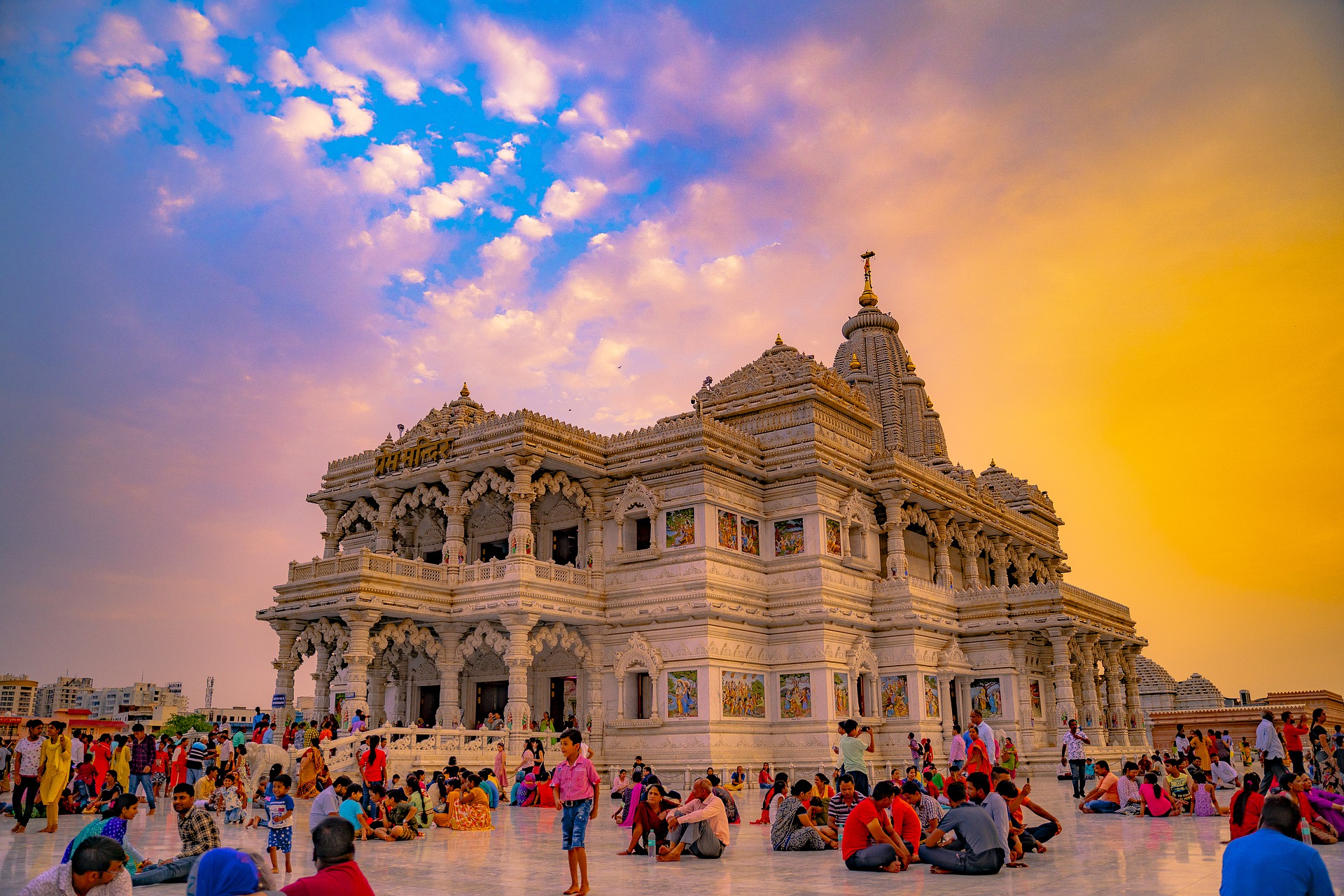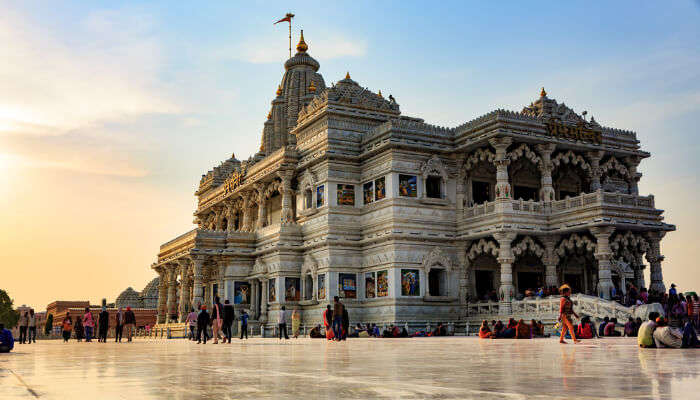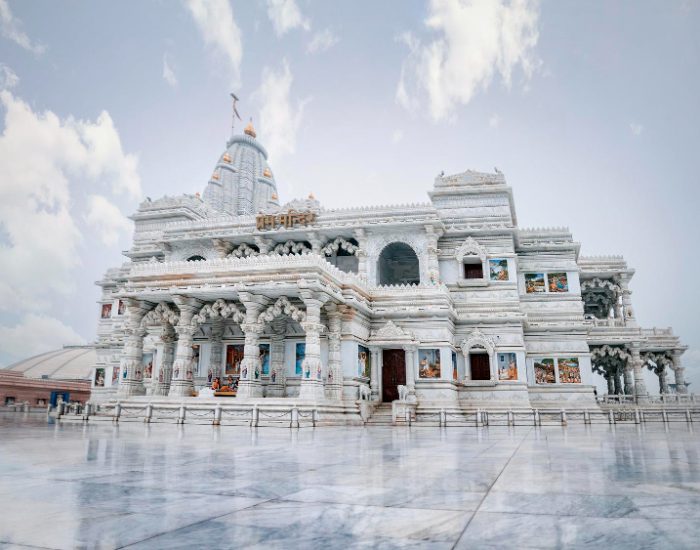Discovering Vrindavan: A Spiritual Haven
Historical Tapestry of Vrindavan: Nestled on the banks of the Yamuna River, Vrindavan is a town steeped in spiritual history, tracing its roots back to ancient times. Recognized as the sacred playground of Lord Krishna, it is believed to be the backdrop of his youthful escapades and divine love stories. Today, Vrindavan stands as a living testament to these legends, with numerous temples and ghats that resonate with the chants and hymns of devotees.
Spiritual Landmarks: At the heart of Vrindavan’s spiritual allure lies its numerous temples, each telling a unique tale of devotion and architectural grandeur. The Banke Bihari Temple, dedicated to Lord Krishna, draws pilgrims with its captivating deity. The ISKCON Temple, a global icon, echoes the International Society for Krishna Consciousness’s message, while the Radha Raman Temple is a testament to the eternal love between Radha and Krishna.
Prem Mandir: A Divine Masterpiece: A prominent jewel in Vrindavan’s crown is the Prem Mandir, a monumental temple showcasing intricate carvings and sculptures narrating the life of Lord Krishna. Its captivating evening light and sound show add a celestial charm, attracting visitors from far and wide.
Sacred Serenity: Vrindavan’s charm extends beyond its temples to the peaceful Yamuna Ghats, where devotees perform rituals and immerse themselves in the sacred waters. The town’s vibrant markets offer a glimpse into the local culture, adorned with vibrant colors, devotional artifacts, and delectable sweets.
Mathura and Vrindavan: Unveiling the Spiritual Tapestry of India
The Indian cities of Mathura and Vrindavan are a living representation of the nation’s rich cultural and spiritual legacy, and they are located on the banks of the holy Yamuna River in the northern state of Uttar Pradesh. Both pilgrims and visitors are drawn to these twin settlements because of its colorful history, rich religious tradition, and intricate ties to Hindu mythology.
Value of Mathura in History: Hindu mythology’s Dwapara Yuga is the source of Mathura, one of the world’s oldest towns. Lord Krishna, one of the most venerated deities in Hinduism, is said to have been born there. Ancient civilizations and kingdoms have left their mark on the city’s historical sites, like the Dwarka dhish Temple and the Krishna Janmabhoomi Temple. Vrindavan, adorned with countless temples, ghats, and ashrams, serves as a spiritual haven for devotees seeking a closer connection with the divine. The Banke Bihari Temple, built in the Brij architectural style, and the ISKCON Temple are among the many revered sanctuaries that draw pilgrims from far and wide.
The Ghats of Yamuna: The Yamuna River, flowing gently through both Mathura and Vrindavan, plays a pivotal role in the spiritual landscape of the region. The ghats along its banks, including Vishram Ghat and Kesi Ghat, serve as sacred venues for religious ceremonies and rituals. Pilgrims partake in the age-old tradition of performing ablutions and prayers, creating a serene and contemplative atmosphere.
Cultural Tapestry and Festivals: Beyond the religious sanctuaries, Mathura and Vrindavan showcase a vibrant cultural tapestry. The lively celebration of festivals, especially during Holi, the festival of colors, transforms the towns into kaleidoscopic spectacles. The streets come alive with music, dance, and the exuberant spirit of revelers, making it an immersive experience for visitors.
Prem Mandir Vrindavan: A Symphony of Devotion and Architecture

Nestled in the sacred town of Vrindavan, Uttar Pradesh, Prem Mandir stands as a radiant jewel, captivating visitors with its sublime blend of devotion and architectural splendor. Translating to “Love Temple,” Prem Mandir is a testament to the divine love of Lord Krishna and Radha, immortalized in the vibrant hues of the temple’s marble façade.
Architectural Marvel: Prem Mandir, inaugurated in 2012, is a marvel of modern temple architecture. Crafted entirely from Italian marble, the temple unfolds like a celestial palace, adorned with intricate carvings depicting episodes from the lives of Lord Krishna and Radha. The temple’s symmetrical design and exquisite detailing showcase a seamless fusion of traditional craftsmanship and contemporary aesthetics.
The Enchanting Light and Sound Show: As dusk descends, Prem Mandir transforms into a spectacle of light and sound. The nightly illumination of the temple, accompanied by a synchronized music and narration, narrates the tales of divine love, creating a mesmerizing experience for devotees and tourists alike. The radiant glow of the temple against the night sky adds a celestial aura to the spiritual ambiance.
Sculptural Grandeur: The temple’s central hall houses breathtakingly lifelike, 3D-effect sculptures depicting various episodes from Krishna’s life. These meticulously crafted sculptures narrate the leelas (divine pastimes) of Lord Krishna, immersing visitors in the enchanting world of devotion. The temple’s sanctum sanctorum features intricately carved idols of Radha and Krishna, inviting devotees to witness the divine union of love.
Reflecting the Spirit of Bhakti: Prem Mandir not only serves as a visual spectacle but also as a pilgrimage site that promotes the spirit of bhakti (devotion). The temple’s serene surroundings and the beautifully landscaped gardens provide a tranquil space for meditation and contemplation, fostering a sense of spiritual introspection among its visitors.
Vrindavan Temple: A Spiritual Odyssey in the Heart of Uttar Pradesh
Historical Roots: Vrindavan, a town synonymous with the eternal love of Radha and Krishna, boasts a rich tapestry of temples, each echoing the divine resonance of Hindu mythology. The town’s temples are not mere architectural marvels; they serve as portals to an ageless era, where the divine and the earthly converged. One such sanctum is the Vrindavan Temple, a sacred space that encapsulates the essence of devotion.
Architectural Splendor: The Vrindavan Temple, often referred to as the Vrindavan Chandrodaya Mandir, is a towering edifice that stands as a testament to both spiritual fervor and architectural prowess. The temple, still under construction, is envisioned to be the world’s tallest religious monument upon completion. Its design seamlessly blends traditional Vedic architecture with modern engineering, creating a structure that pays homage to the ancient while embracing the contemporary.
Radha and Krishna: At the heart of the Vrindavan Temple lies the divine couple, Radha and Krishna, whose celestial love story unfolds through the temple’s intricate carvings and sacred depictions. The sanctum sanctorum houses exquisitely adorned idols, inviting devotees to immerse themselves in the divine leelas (pastimes) of Radha and Krishna. The temple acts as a spiritual abode where seekers can connect with the transcendental love that permeates Vrindavan’s hallowed grounds.
Spiritual Practices: The Vrindavan Temple is not merely a sightseeing destination; it’s a spiritual epicenter where devotees engage in various rituals and practices. From the rhythmic chants of bhajans to the mesmerizing sound of temple bells, the atmosphere reverberates with the energy of devotion. Pilgrims undertake parikrama, circumambulating the temple, as a symbolic journey of devotion and surrender.
Cultural and Educational Hub: Beyond its religious significance, the Vrindavan Temple aspires to be a cultural and educational hub. Plans include a museum showcasing the rich heritage of Vrindavan, a study center disseminating Vedic knowledge, and a vibrant cultural complex fostering artistic expressions of devotion.
Mathura to Vrindavan Distance: A Pilgrim’s Journey Across Spiritual Realms

Geographical Proximity: The sacred towns of Mathura and Vrindavan, both steeped in Hindu mythology, are intimately connected not only by spirituality but also by geographical proximity. Situated in the northern Indian state of Uttar Pradesh, the distance between Mathura and Vrindavan is a mere 15 kilometers, making them twin jewels in the crown of spiritual destinations.
Historical Significance: Embarking on a journey from Mathura to Vrindavan is more than a mere traverse of physical distance; it’s a pilgrimage through the annals of history. Mathura, hailed as the birthplace of Lord Krishna, brims with historical landmarks such as the Krishna Janmabhoomi Temple, linking the present to the ancient tales of divine incarnations. The path to Vrindavan, with its lush landscapes, resonates with the footsteps of Lord Krishna during his enchanting leelas.
Sacred Pathways: The route from Mathura to Vrindavan is not just a mundane passage but a sacred pathway paved with centuries of devotion. Pilgrims and visitors often traverse this distance with a sense of reverence, retracing the footsteps of saints and sages who have undertaken this journey in search of spiritual solace. The Yamuna River, flowing gently alongside, adds a serene backdrop to this soul-stirring expedition.
Vibrant Cultural Landscape: As one approaches Vrindavan, the cultural landscape undergoes a seamless transition. The town, adorned with numerous temples and ashrams, beckons with an invitation to delve into the vibrant hues of devotion. The Banke Bihari Temple and the iconic ISKCON Temple are among the spiritual landmarks that unfold as treasures along the way, encapsulating the essence of Vrindavan’s cultural and religious vibrancy.
Conclusion
In the embrace of Vrindavan’s timeless spirituality and architectural grandeur, the journey from the historical roots of Mathura to the radiant Prem Mandir unfolds as a symphony of devotion. The sacred landscape, adorned with temples and tranquility, narrates the divine tales of Radha and Krishna, resonating through the ages. As pilgrims traverse the mere 15 kilometers from Mathura, they traverse not just a physical distance but a sacred pathway, retracing the footsteps of saints and immersing themselves in the vibrant cultural tapestry. The Vrindavan Temple, Prem Mandir’s celestial charm, and the tranquil Yamuna Ghats encapsulate the essence of this spiritual odyssey, offering seekers a profound connection with the divine love that permeates every corner of these sacred towns. In this exploration of spiritual beauty, Vrindavan stands as a testament to the enduring legacy of devotion, inviting all to partake in its transcendent tranquility and architectural splendor.
Frequently Asked Questions (FAQs)
- What is the historical significance of Vrindavan?
- Answer: Vrindavan, nestled on the banks of the Yamuna River, is steeped in spiritual history and recognized as the sacred playground of Lord Krishna. It is believed to be the backdrop of Krishna’s youthful escapades and divine love stories.
- Which temples in Vrindavan are known for their architectural grandeur?
- Answer: Vrindavan boasts numerous temples with unique tales of devotion and architectural splendor. The Banke Bihari Temple, dedicated to Lord Krishna, the iconic ISKCON Temple, and the Radha Raman Temple are notable landmarks.
- Tell us about the significance of Prem Mandir in Vrindavan.
- Answer: Prem Mandir is a monumental temple in Vrindavan, showcasing intricate carvings and sculptures narrating the life of Lord Krishna. Known as the “Love Temple,” it is a divine masterpiece crafted from Italian marble, offering a captivating evening light and sound show.
- What spiritual landmarks are found in Mathura and Vrindavan?
- Answer: Mathura, one of the oldest cities globally, is known for the Krishna Janmabhoomi Temple and Dwarkadhish Temple. In Vrindavan, the Banke Bihari Temple, ISKCON Temple, and the upcoming Vrindavan Temple are significant spiritual landmarks.
- How far is Vrindavan from Mathura, and what makes the journey spiritually significant?
- Answer: The distance between Mathura and Vrindavan is a mere 15 kilometers, highlighting their intimate connection. The journey symbolizes a pilgrimage through history and mythology, with lush landscapes and the Yamuna River serving as sacred pathways for devotees and seekers alike.

